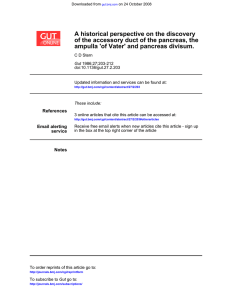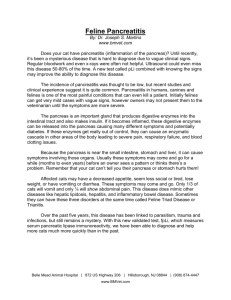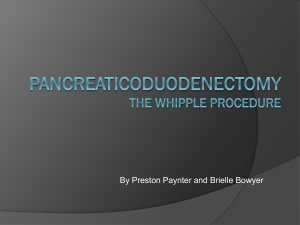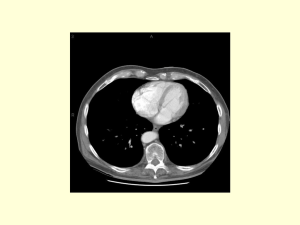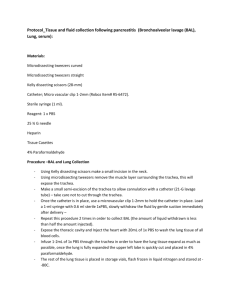ampulla 'of Vater' and pancreas divisum
advertisement
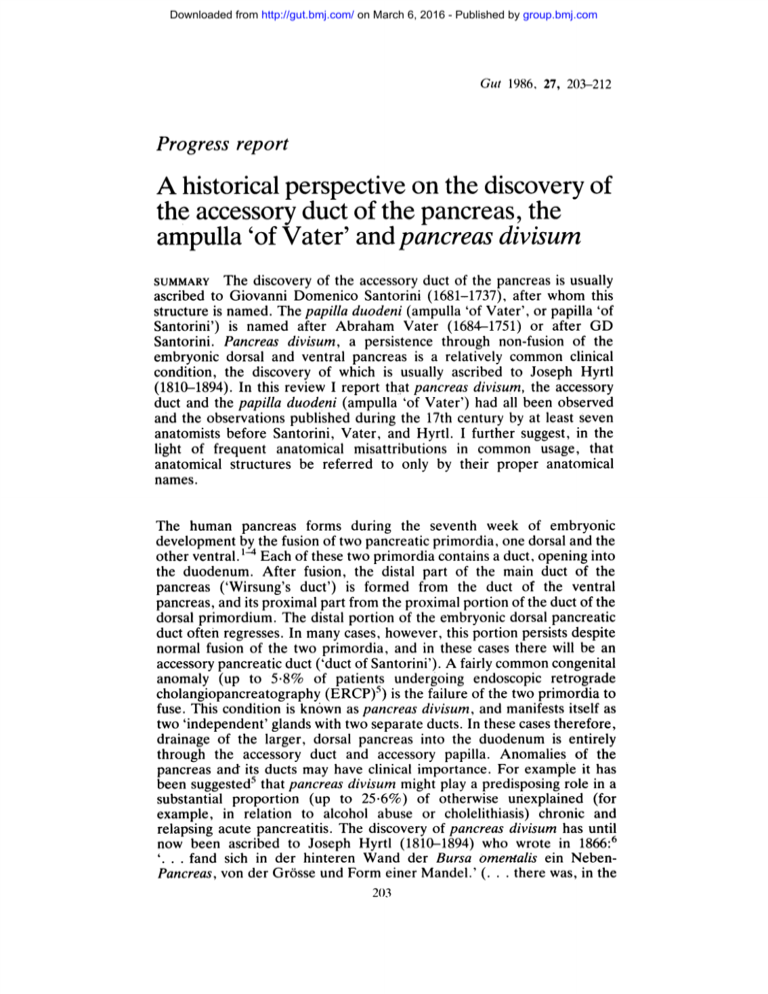
Downloaded from http://gut.bmj.com/ on March 6, 2016 - Published by group.bmj.com
Gut 1986, 27, 203-212
Progress report
A historical perspective on the discovery of
the accessory duct of the pancreas, the
ampulla 'of Vater' and pancreas divisum
SUMMARY The discovery of the accessory duct of the pancreas is usually
ascribed to Giovanni Domenico Santorini (1681-1737), after whom this
structure is named. The papilla duodeni (ampulla 'of Vater', or papilla 'of
Santorini') is named after Abraham Vater (1684-1751) or after GD
Santorini. Pancreas divisum, a persistence through non-fusion of the
embryonic dorsal and ventral pancreas is a relatively common clinical
condition, the discovery of which is usually ascribed to Joseph Hyrtl
(1810-1894). In this review I report that pancreas divisum, the accessory
duct and the papilla duodeni (ampulla 'of Vater') had all been observed
and the observations published during the 17th century by at least seven
anatomists before Santorini, Vater, and Hyrtl. I further suggest, in the
light of frequent anatomical misattributions in common usage, that
anatomical structures be referred to only by their proper anatomical
names.
The human pancreas forms during the seventh week of embryonic
development by the fusion of two pancreatic primordia, one dorsal and the
other ventral.1 4Each of these two primordia contains a duct, opening into
the duodenum. After fusion, the distal part of the main duct of the
pancreas ('Wirsung's duct') is formed from the duct of the ventral
pancreas, and its proximal part from the proximal portion of the duct of the
dorsal primordium. The distal portion of the embryonic dorsal pancreatic
duct often regresses. In many cases, however, this portion persists despite
normal fusion of the two primordia, and in these cases there will be an
accessory pancreatic duct ('duct of Santorini'). A fairly common congenital
anomaly (up to 5-8% of patients undergoing endoscopic retrograde
cholangiopancreatography (ERCP)5) is the failure of the two primordia to
fuse. This condition is known as pancreas divisum, and manifests itself as
two 'independent' glands with two separate ducts. In these cases therefore,
drainage of the larger, dorsal pancreas into the duodenum is entirely
through the accessory duct and accessory papilla. Anomalies of the
pancreas and its ducts may have clinical importance. For example it has
been suggested5 that pancreas divisum might play a predisposing role in a
substantial proportion (up to 25.6%) of otherwise unexplained (for
example, in relation to alcohol abuse or cholelithiasis) chronic and
relapsing acute pancreatitis. The discovery of pancreas divisum has until
now been ascribed to Joseph Hyrtl (1810-1894) who wrote in 1866:6
'. . . fand sich in der hinteren Wand der Bursa omentalis ein NebenPancreas, von der Grosse und Form einer Mandel.' (. . . there was, in the
203
Downloaded from http://gut.bmj.com/ on March 6, 2016 - Published by group.bmj.com
204
Stern
posterior wall of the omental bursa, an accessory pancreas, of the size and
shape of an almond).
The accessory duct of the pancreas is named after Giovanni Domenico
Santorini (1681-1737) who in his Septendecim Tabulae (published posthumously by Michael Girardi in 1775)7 produced a clear drawing of the
pancreas and its accessory duct (Tabula XIII) and a clear description of this
duct.
An embryological interpretation of the presence of an accessory duct
and of pancreas divisum was not afforded until at least 1812, when
Meckell reported that the pancreas arises from the fusion of dorsal and
ventral primordia in the embryo. For this reason, early descriptions of
cases of pancreas divisum and of the accessory duct often do not make a
clear distinction between the two. Although such a distinction could have
clinical importance since in pancreas divisum pancreatic drainage may be
impaired, this distinction may be of less relevance from the embryological
point of view, and a whole gradation of 'penetrance' of pancreatic duct
anomalies has been described. From the clinical point of view, the
(somewhat arbitrary) criterion for distinction between the two types of
anomaly is whether or not the accessory duct and the main duct are in
communication.
Early descriptions
PANCREAS DIVISUM AND THE ACCESSORY DUCT
The earliest published description of an accessory duct is that of Thomas
Wharton (1614-1673) (Fig. la), who, in his Adenographia of 1656 states
about the pancreas:'. . . in diversis animalibus plurimum variat. In
piscibus aliquibus, ad pennatorum genre, duplex, cum duplicie ductu, ab
utroque extremo in unum truncum coeunte . . .' (.. . it is variable in
different animals. In some fishes and winged creatures it is double with a
double duct, which unite at the other extreme in a single trunk . . .).
By this time, however, Johan Rhode (1587-1656) (Fig. lb) had already
(1646 and 1647) made his own observations of two cases of patent
accessory ducts in Man, but his description was not published until 1661
(Fig. 2): 'XXX. Ductus pancreaticus geminus. An. 1646. 15. Januar. in
cadavere mulieris e valetudinario Patavino ductus pancreaticus manifeste
geminus in duodenum intestinum migravit. Anni sequentis Januario 24 in
virili cadavere idem obvenit'. (15 January, 1646. In a female cadaver from
the hospital in Padua, the pancreatic duct was clearly double leading into
the duodenum. The next year, on 24 January, I found the same in a male
cadaver). This is the earliest description of the accessory duct of the
pancreas in man (for biographies of Wirsung and Rhode see references 10
and 11).
In 1664, the Danish anatomist Niels Stensen (Fig. lc) also reported cases
of double pancreatic ducts in birds,12 and the same year Regnier de Graaf
(Fig. ld) made a similar observation in animals and in man (the followin
quotation is taken from a contemporary, 1676 English translation):'3
'. . . There are some animals which have only one single pancreatick duct.
Others there are which have it double, and lastly some have three, when
the ductus is single; sometimes it enters with the ductus biliarius into the
intestinum duodenum, and sometimes a part. When the ductus is
Downloaded from http://gut.bmj.com/ on March 6, 2016 - Published by group.bmj.com
205
Historical perspective on the pancreas
(From top, left to right) (a) Thomas Wharton
(1614-1673) oil paintintg bv unknown artist c. 1650. (b) Johan
Rhode (1587-1659) engraving from his De acia dissertatio,
Fig. I
1672. (c) Niels Stensen (1638-1686) oil paizting by unknown
artist, after an anonyvmous oil painting in the Clergy House.
Schwerin. (d) Regnier de Graaf (1641-1673) engraving by
P Pinchard. (e) Frederik Ruysch (1638-1731) aged 86,
engraving by 1 Wandelaar, 1723. ( Franciscus de le Boe
Sylvius (16i4-1672) aged 45, engraving by C van Dalen Jr,
1659. (g) Samuel Collins (1618-1710) at age 67, engraving by
W Fairthorne from his Systeme of Anatomy, 1685.
(a, printed with permission of the Royal College of
Physicians, London, b, c, e, f and g printed with permission
from the portraits collection of the Wellcome Institute
Library, London; dfrom the University Library,
Cambridge).
&k
Caz
I2SANNE.>~Rti0f)l\:v
S4
4,e
CDg: D:K XLVrll,
4(l
...tj tiP
....W_...,
W.:--w
0,..
B
i.
'i-
i
Downloaded from http://gut.bmj.com/ on March 6, 2016 - Published by group.bmj.com
206
Stern
.o
~00
.W .>
'o
L14i
Downloaded from http://gut.bmj.com/ on March 6, 2016 - Published by group.bmj.com
Historical perspective on the pancreas
207
duplicate, sometimes one, sometimes both meet together with the ductus
biliarius in the intestine. But when the ductus is three-fold sometimes one
only, sometimes two and sometimes all three enter into the intestine by the
same passage, and also therein lie a contained humour' . . . 'in Men and
Dogs we find it sometimes double' . . . 'As often as these two ducts happen
in the Animals now cited, for the most part they are conjoyned in the
Pancreas, so that the one being blown up, the other will swell; yet we find
them so constituted in Man, that they are not joyned together although
both be extended to the extremity of the Pancreas almost in the same
Longitude and Magnitude'. This latter statement makes it plain that Graaf
is referring to the accessory duct in what we would now classify as a case of
pancreas divisum. The following year (1665), Frederik Ruysch (Fig. le)
made similar observations,'4 but is careful to point out that Graaf had
already described the same.
Graaf had received his inspiration from Franciscus de le Boe Sylvius
(1614-1672) (Fig. lf), who in 1679 published his Opera Medica,15 in which
he also makes a passing reference to duplicate pancreatic ducts.
In 1685, Samuel Collins (Fig. lg) published his massive Systeme of
Anatomy . . . (Fig. 3).16 Within it are contained detailed descriptions
(more than four chapters) of the anatomy of the human pancreas, observed
variations in its structure, and cases of pathology. Among them, the
following unambiguous decription of pancreas divisum: 'A man for the
most part hath but one Pancreatick Duct, and rarely two, which was
discovered in a Woman Dissected in the Colledg Theatre, who had two
Pancreas, and two Ducts (inserted into the Duodenum at some little
distance) between which in the middle way, the Hepatick Duct was
implanted into the first small Gut'. He describes the accessory pancreatic
duct thus: 'The Excretory Vessels are numerous, and begin in small
Capillaries, . . . and from these Minute Capillaries, do branch themselves
and grow greater and greater, as they approach the middle of the Pancreas,
where they unite, and concenter for the most part in one common Duct,
and rarely in two, and then they are of unequal bigness; the greatest
running along the middle, and the smaller a little below, and do both
coalesce near the Duodenum . .
The number of publications on the pancreas and its ducts at around this
time was such that it astonished some 17th century observers as much as it
will the modern anatomist. One author, Johann Nicholaus Pechlin (who
wrote under the pseudonym of Janus Leonicenus Veronensis), reacted by
publishing, in 1673, a work entitled Metamorphosis Aesculapii et Apollinis
Pancreatici,17 a caricature of the vast proliferation of works on the
pancreas, with Wharton, Aselli, Wirsung, Graaf, and Sylvius as his main
targets. Graaf's description of the double pancreatic ducts (the same as I
quoted above) is condemned as 'horribilis cacophonia', and Wirsung's,
Wharton's and Aselli's work as 'aequivocationes and cacographia'.
THE PAPILLA DUODENI (AMPULLA 'OF VATER')
The papilla duodeni (=hepatopancreatic ampulla, =ampulla 'of Vater') is
named after Abraham Vater (1684-1751), who published a description of
this region in 1720.18 That Vater was its discoverer has already been
disputed, and the honour transferred to GD Santorini himself.19 According to Velasco-Suarez, 19 the ampulla 'of Vater' should be known as
Downloaded from http://gut.bmj.com/ on March 6, 2016 - Published by group.bmj.com
Stern
208
I1I
0
._
~
o
._
~
~
St
<'0
00
oo
0
c._
U)
'0
.4
LN
0
utz
Downloaded from http://gut.bmj.com/ on March 6, 2016 - Published by group.bmj.com
Historical perspective on the pancreas
209
'Santorini valves', because of Santorini's description.7 As early as 1685,
however, Samuel Collins16 already provides a clear description of the
ampulla: '. . . the Termination of the Pancreatick Duct is inserted, about
four Fingers below the Pylorus, where a Prominence, or little Teat, may be
discovered near the flexure of the Duodenum, about the egress of the
Porus Bilarius in Man, and in Dogs at a Fingers breadth distance below the
entrance of the Hepatick Duct (into the Duodenum) into which it is
sometimes inserted'. It should be pointed out that Andreas Vesalius had
already given an obscure account of this region in 1543.20 Furthermore,
Velasco-Suarez himself (albeit somewhat obtusely) acknowledges that
Santorini was not the first to have observed the valves in the ampulla: '. . .
the valves discovered by Santorini in 1720 and made known by Vesalius in
1543 . . .' 19
Comments
Did Santorini know about the observations of the earlier anatomists? One
interesting insight into the answer to this question comes from examination
of the Bibliotheca Anatomica of Leclerq and Manger (lst ed 1685, 2nd ed
1699),21 a splendid compendium of writings of many contemporary and
earlier anatomists. Both editions of the Bibliotheca Anatomica contain
references to supernumerary pancreas and to double pancreatic ducts,
including some of the works of Wharton, Ruysch, Stensen, and de Graff.
(Wharton's chapters 10 and 11, where he reports his double pancreatic
ducts, are not included, but Graaf's text is included in full, with two pages pp. 212-213 of the 1699 edition - on the pancreatic ducts). Lorenzo Bellini
(1643-1704), probably one of Santorini's teachers,22 was recommended
this book by Marcello Malpighi himself, as evidenced by extant correspondence between the two. 2-24 A more bizarre direct link between
Santorini and Malpighi is that one of Santorini's editors, Giorgio Baglivi,
performed the necropsy on Malpighi's own body in 1694.22 Bellini finally
obtained a copy of the book in 1699 and was impressed by it. It was in 1699
that the 2nd edition appeared, and at this time Santorini was a medical
student (as he received his doctorate two years later). It is very likely,
therefore, that Santorini was acquainted with this book in his student
years. Furthermore, Santorini's 1775 editor, M Girardi, makes reference
to Graaf's discovery (ref. 7, p. 150): 'Quamquam Graafius, qui accuratio
caeteris Spartam hanc excoluisse videtur, duplicis pancreatis ductus .
(Although Graaf with exactness and perfection saw the double pancreatic
ducts . . .). Girardi chose to place this reference to Graaf just before
Santorini's description of the accessory duct, and justifies Santorini's
observations by considering them to be 'better' than Graaf's.
It is worth remembering that the importance assigned to priority is a
comparatively recent preoccupation. Questions of plagiarism and priority
would have been much less likely to have arisen in the 17th-18th centuries.
As it is obvious that by the end of the 17th century pancreas divisum, the
papilla duodeni and the accessory pancreatic duct were all well known, it
seems a mystery how the observations of these early anatomists have been
forgotten and how the discoveries have been misattributed to later
anatomists, who not even always had improved upon the detail of the
earlier accounts. In the case of Collins's work, a possible explanation may
be found in that his work was only published in English, a language which
Downloaded from http://gut.bmj.com/ on March 6, 2016 - Published by group.bmj.com
210
Stern
continental anatomists were unable to read. For example, in his Histoire de
l'Anatomie, Portal22 attempts to conceal that he never read the book:
Collins (Samuel), Anatomiste Anglois. Systema anatomicum. Lond. 1685,
in-fol. Il y a peu de details Anatomiques qui concernent l'homme; l'auteur
s'est plus etendu sur l'anatomie des oiseaux and des poissons, dont il a
decrit les ecailles and leurs glandes cutanes; il a depeint le trou borgne de la
langue, and les papilles nerveuses. . .'. (Collins. English Anatomist....
There are few anatomical details concerning Man; the author is more
interested in the anatomy of birds and fishes, of which he described the
scales and their cutaneous glands . . .). It is less easy to understand why the
observations of Wharton, Rhode, Graaf, Stensen, Sylvius, and Ruysch,
who did write in Latin, have been forwotten. This is especially puzzling
since Santorini's/Girardi's 1775 work, which is widely quoted does
acknowledge Graaf's findings. One reason might be, once again, the
language of the texts. Most of the writings of this period are in Latin, and
only a few contemporary anatomists are willing to take the trouble to read
them.
Conclusions
The foregoing discussion shows that at least seven 17th century anatomists
were aware of the existence of an accessory pancreatic duct 'of Santorini'
before Santorini's own observations. They were also aware of the anomaly
now known as pancreas divisum long before Joseph Hyrtl, who is generally
credited with the first description of this condition in 1866. One of these
anatomists, Samuel Collins, in 1685, published a clear description of the
ampulla 'of Vater' before Vater's own description in 1720. In the light of
these observations I suggest that hitherto these structures be referred to
only by their proper anatomical names: ductus pancreaticus accessorius
(accessory duct of the pancreas), pancreas divisum, pancreas accessorium,
ampulla hepatopancreatica (hepatopancreatic ampulla) and papilla duodeni major and minor, as defined in the Nomina Anatomica.
This review started life as a lecture on the history of pancreas divisum
delivered to the International Workshop on Pancreas Divisum in London
on 13 December, 1984, and organised by Drs P B Cotton and J Lowes and
Mr R C G Russell. I am grateful to Drs Cotton and Lowes for the
invitation to attend and for having initiated my interest in this subject. The
research I have done would not have been possible without the generous
help given by the staff of several libraries: the Anatomy Department,
Cambridge, the Cambridge University Library, the Whipple Museum
Library (Cambridge); the British Library Reference Division (London),
the Wellcome Institute for the History of Medicine Library (London), the
Library of the Royal College of Physicians (London). I must also single out
the help of Mr W Simons, librarian to the Department of Anatomy,
Cambridge, for his enthusiastic help, and that of the Audio-Visual Aids
unit in the same department who carried out much of the photographic
work for the lecture and this review.
Department of Human Anatomy,
South Parks Road, Oxford OX] 3QX.
CLAUDIO D STERN
Downloaded from http://gut.bmj.com/ on March 6, 2016 - Published by group.bmj.com
Historical perspective on the pancreas
211
Bibliography
(Library references refer to copies consulted).
1 Meckel JF Jr, Handbuch der pathologischen Anatomie. Leipzig: C -H Reciam. ii-2.
2 Hamilton WJ, Mossman HW, eds. Hamilton, Boyd and Mossman's Human Embryology.
4th ed. London: Williams and Wilkins, 1976.
3 Williams PL, Warwick R, eds. Gray's anatomy. 36th ed. Edinburgh: Churchill
Livingstone, 1980.
4 Mitchell CJ. Pancreas divisum and pancreatitis. In: Mitchell CJ, Kelleher J, eds.
Pancreatic disease in clinical practice. London: Pitman, 1981: 404-14.
5 Cotton PB. Congenital anomaly of pancreas divisum as cause of obstructive pain and
pancreatitis. Gut 1980; 21: 105-14.
6 Hyrtl J. Ein pancreas accessorium und Pancreas Divisum. Sitz. Mathematisch-Naturwiss.
Classe d K Akad Wissenschaften (Wien) 1865; 52: 275.
7 Santorini GD. Septendecim tabulae quas nunc primum edit atque explicat iisque alias addit
de structura Parmensi universitate anatomes professor primarius, etc. 1775; Parmae ex
regia typographia. Fol. (British Library 59.f.12; Wellcome Institute Hist. Med.).
8 Wharton T. Adenographia sive glandularum totius corporis descriptio. London: 8vo. 1656.
(Cambridge Univ. Library K. 12.7 and P*.6.26(F)). Other editions: Amsterdam 1659,
12mo (Cambridge U.L. Hh. 19.29), Noviomagi 1665, 12mo. (Cambridge U.L. K.18.110),
Vesaliae 1671, 12mo., Geneva 1685, fol.
9 Rhodius J. Mantissa anatomica, extat cum Thom. Bartholini historiarum anatomicar. and
medicar. rarior. Centuria V and VI. 1661; Hafniae 8vo. (Cambridge Univ Library
N*.14.14(F).
10 Premuda L, Gamba A, Per la biografia di J. G. Wirsung e per la storia della scoperta del
dotto pancreatico. Acta Med Hist Patav 1974; 21: 53-88.
11 Snorrason E, Der Dane Johan Rhode in Padua des 17.Jahrhunderts. Acta Med Hist Patav
1967; 14: 85-120.
12 Stensen N. Observationum anatomicarum de musculis glandulis specimen, cum epistolis de
anatomia Rajae, ex et vitelli in intestina pulli transitu. 1664; Hafniae, 4to. (Other editions:
Amsterdam 1664, 12mo).
13 Graaf R de. Disputatio medica, de natura et usu succi pancreatici. 1664; Lugd. Batav.,
12mo. Other editions: 1671 in 8vo., 1674 in 8vo. Original in French: Traite de la nature and
de l'usage du suc pancreatique. 2nd ed. Paris 1666, 12mo. English translation publ.
London 1676 (Cambridge Univ Library E*.15.42(F)).
14 Ruysch F, Dilucidatio valvularum in vasis lymphaticis et lacteis, cum figuris aeneis.
Accesserunt quaedam observationes anatomicae rariores. 1665; Hagae Comitis, 8vo.
(Other editions: 1687. Cambridge Univ Library Adams.8.68. 11).
15 Sylvius F de le Boe. Opera Medica. 1679; Amsterdam, 4to. (Cambridge University
Library U*.5.70(D), K.14.40 etc. - 6 copies. Other editions include a folio ed. of 1681,
Cambridge U.L. K.13.24, etc).
16 Collins S. A systeme of anatomy, treating of the body of man, beasts, birds, fish, insects and
plants. Illustrated with many schemes, consisting of variety of elegant figures, drawn from
the life, and engraven in seventy four Folio copper plates and after every part of man's body
hath been anatomically described, its diseases, cases and cures are concisely exhibited. 1685;
London, 2 vols., fol. (Anatomy Department, Cambridge S.9H.101).
17 Leonicenus J (Veronensis) (pseudonym of Johann Nicholaus Pechlin). Jani Leoniceni
Veronensis Metamorphosis Aesculapii et Apollinis Pancreatici. 1673; Lugd. Batav.: apud
Philippum Bonum. 8vo. (British Library 1033.d.26.(1)).
18 Vater A. Dissertatio anatomica qua novum bilis diverticulum circa orificium ductus
cholodochi ut et valvulosam colli vesicae felleae constructionem . .. 1720; Wittenbergae,
Lit. Gerdesianus, 4to. (Wellcome Inst Hist Med A.I.f(20) 13298).
19 Velasco-Suarez C. The Santorini valves. Mt Sinai J Med (NY) 1981; 48: 149-57.
20 Vesalius A. De humani corporis fabrica. 1543; Basileae: loan. Operinum, fol. (Anatomy
Department, Cambridge M.la.4, L.C.62).
21 Leclerq D, Manger JJ, (Daniel Clericus and J Jacob Mangetus). Bibliotheca Anatomica,
sive recens in anatomia inventorum Thesaurus locupletissimus, in que integra atque
absolutissima ... (2 vols.) 1685; Genevae: J A Chouet (Chovet). (fol.) 2nd ed: Genevae:
J A Chouet and D Ritter (fol.) (Both eds. Department of Anatomy, Cambridge M.1,5-6).
22 Portal A. Histoire de l'anatomie et de la chirurgie, contenant l'origine et les progres de ces
Sciences. Avec un Tableau Chronologique des principales decouvertes, et un catalogue des
ouvrages d'Anatomie ... 1770-1773; Paris, 8vo. (6 vols.) (Department of Anatomy,
Downloaded from http://gut.bmj.com/ on March 6, 2016 - Published by group.bmj.com
212
Stern
Cambridge, L.2.5-10).
23 Atti G. Notizie edite ed inedite delle vite e delle opere di Marcello Malpighi e di Lorenzo
Bellini. 1847; Bologna.
24 Adelmann H. Marcello Malpighi and the evolution of embryology. (5 vols.) 1966; Ithaca
(NY): Cornell University Press.
Downloaded from http://gut.bmj.com/ on March 6, 2016 - Published by group.bmj.com
A historical perspective on the
discovery of the accessory duct of the
pancreas, the ampulla 'of Vater' and
pancreas divisum.
C D Stern
Gut 1986 27: 203-212
doi: 10.1136/gut.27.2.203
Updated information and services can be found at:
http://gut.bmj.com/content/27/2/203
These include:
Email alerting
service
Topic
Collections
Receive free email alerts when new articles cite this article.
Sign up in the box at the top right corner of the online article.
Articles on similar topics can be found in the following
collections
Pancreas and biliary tract (1927)
Notes
To request permissions go to:
http://group.bmj.com/group/rights-licensing/permissions
To order reprints go to:
http://journals.bmj.com/cgi/reprintform
To subscribe to BMJ go to:
http://group.bmj.com/subscribe/

